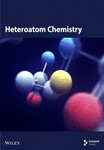Addition of a stable dialkylsilylene to carbon–carbon unsaturated bonds†
Dedicated to Professor Kin-ya Akiba on the occasion of his 75th birthday.
Abstract
The reactions of an isolable dialkylsilylene, 2,2,5,5-tetrakis(trimethylsilyl)silacyclopentan-1,1-diyl (1) with ethylene, (Z)-2-butene, acetylene, bis(trimethylsilyl)acetylene, and 2,3-dimethylbutadiene at room temperature gave the corresponding silacycles as isolable compounds. Because of the large steric hindrance, the reaction of 1 with (E)-2-butene gave a complex mixture, indicating no formation of the corresponding silirane. The reaction of 1 with 2,3-dimethylbutadiene afforded the corresponding [1 + 4] cycloadduct without contamination of the [1 + 2] cycloadduct. Stable C-unsubstituted silirane and silirene produced by the reactions of 1 with ethylene and acetylene were analyzed by X-ray crystallography. © 2011 Wiley Periodicals, Inc. Heteroatom Chem 22:432–437, 2011; View this article online at wileyonlinelibrary.com. DOI 10.1002/hc.20705




